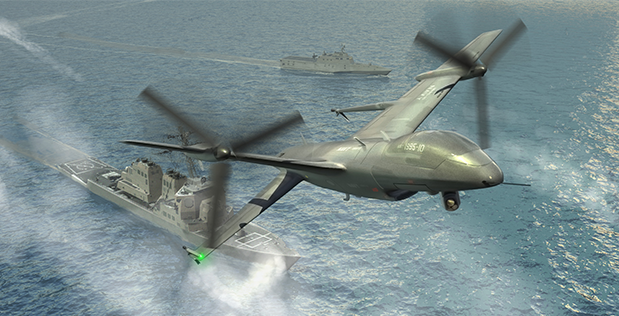
SAN DIEGO – The Marine Corps is reconsidering the requirements for its large amphibious ship-based unmanned aerial system (UAS), after early industry input showed the service was headed towards something too large and too expensive, the deputy commandant for combat development and integration told reporters today.
Lt. Gen. Robert Walsh said the Marine Air-Ground Task Force (MAGTF) UAS Expeditionary (MUX) program proves why industry input during the requirements-generation process is so important. The MUX initial capabilities document (ICD) made its way through the Joint Requirements Oversight Council process in October 2016 because the Marines were able to prove they were seeking a capability not already found in the joint force – specifically, a large Group 4 or Group 5 UAS capable of operating from a ship or small expeditionary airfield and conducting intelligence, surveillance and reconnaissance (ISR) missions.
What the JROC failed to see, though, which industry has told the Marine Corps recently, is that the requirements lend themselves to an MV-22 Osprey-like vehicle in terms of size and cost, Walsh told reporters after speaking at the WEST 2018 event, cohosted by the U.S. Naval Institute and AFCEA.
The MUX program merges what used to be two requirements, and covers seven mission areas, USNI News has previously reported: MAGTF C4 (Command, Control, Communications and Computing with Spectrum Agile Data Routing); early warning; persistent fires; escort; electronic warfare; reconnaissance, intelligence, surveillance and target acquisition (RISTA); and tactical distribution.
“If you look at the (San Antonio-class) LPDs that are out, many times doing their own operations – could be off of Africa, someplace doing operations – they need organic ISR capability,” Walsh said.
“When you look at our LHAs, our big deck, our ARG/MEUs (Amphibious Ready Groups/Marine Expeditionary Units), the thing that I think we’re missing is a platform that can go out against this kind of threat: long range, airborne early warning, has [electronic warfare] capabilities, ISR capabilities. The ICD we wrote was really all-encompassing: we were calling it a Group 4 or Group 5 that could have logistics capabilities with it, so we started really working with the contractors off the ICD and what we were kind of getting from them was, boy, this is a pretty big broad capability – this is going to be big and this is going to be expensive. They were almost looking to develop a V-22 unmanned sized and cost aircraft. So we looked at that and said, okay, that’s why we’ve got to work with industry more as we develop requirements.”
Ultimately the Marine Corps decided that industry was already investing in sophisticated unmanned logistics systems, which the service has learned through its Sea Dragon experimentation efforts. So the unmanned airborne logistics piece will likely be broken off from MUX and addressed through other means, Walsh said.
Narrowing the scope of the MUX requirements will allow more time and attention for other trades: “should it escort a V-22? Should it be armed? Those are the kind of things we’re going to have to kind of neck down and figure out the cost and what do we really need,” Walsh said.
“What we really need for sure is an unmanned system coming off of an ARG/MEU, could come off the LPD or LX(R) also, that can have long-dwell airborne early warning and ISR capabilities that we don’t have right now.”
Walsh said his colleague, Deputy Commandant for Aviation Lt. Gen. Steven Rudder, wants to release a request for information on the MUX program soon, but Walsh hopes to first conduct an industry symposium to further inform the requirements before Rudder takes over the program acquisition. The symposium, which will likely be held in the next month or two, will take industry ideas and help shape the upcoming analysis of alternatives (AoA).
“What we want to do is give the AoA a much better start, because we’re already … hearing from industry, you’re asking for too much, it’s going to cost too much. And I’m going, well why would I start the AoA if they’re already telling me that?” Walsh said.
“So we want to take the time, take a pause, get with them and start the AoA with the right requirements before we move forward.”





